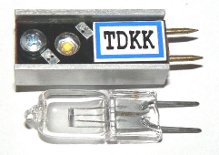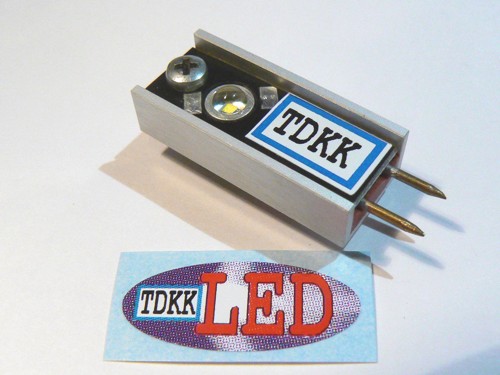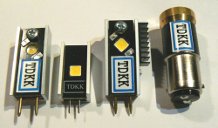Microscope Light Bulb
- The New LED Light -
 |
The quality of the image seen through your microscope is determined by the illumination emitted from the microscope light bulb. In the very early days, a candle and a mirror where used, or if you could afford it, an incandescent light source was beamed onto the mirror. |
Halogen
Later built-in light systems became common, and a big improvement came around 1980 with the introduction of halogen lamps as a light source.
How did image quality improve with the introduction of a halogen microscope light bulb? Mainly due to the “whiteness” of its light.
Incandescent bulbs radiate an orange colored light and so had to be filtered through a blue filter to obtain a somewhat white color. Halogen is already a yellowish white by itself, and therefore has less need for a blue filter.
Also the filament of a halogen bulb is often much finer coiled, this is good for the homogeneous spreading of light.
A problem with both of these light sources arose when light intensity became adjustable. A lamp that is not at its (normal) maximum power will radiate a much “warmer” tint, thus showing more orange or yellow hues. At every other setting, the light color is unequal to the previous setting.
Our eyes can handle that within a certain range, but if you have mounted a camera to your microscope, it should be adjusted with a white balance after every light intensity change.
Otherwise the sensitive element of the camera will show you images with all kinds of different background colors.
The New LED
Recent novel techniques for creating white light with a LED source, and the development of types with enough power that could illuminate a microscope image have paved a whole new path in imaging.
LED (Light Emitting Diode) is a solid state light source that works in a completely different way than a lamp. There is no filament that is heated, but a crystal that emits photons (this will hopefully be explained further in a subsequent article).
The main advantage of the white LED is that the emitted color is inherent to the construction of that emitter. Therefore, a white led cannot emit yellow or orange light but only white.
Due to a lack of a filament, the light is emitted from one single spot, which gives a very good homogeneous spreading of light, in all “corners” of the image. You can do with one diffuser less.

When the manufacturer of the microscope (or TDKK substitute LED lamp) has selected a nice white tone, this will be consistent through all intensity settings, and through the entire life cycle of the LED.
LEDs have “their own” white tone indicating scale, so called degrees Kelvin. (K) Where a 6500 K LED has a kind of blueish tint, a 5000 K model is pure white. A 4000 K model gives a very pleasant microscope image color.
LEDs with a color temperature of 2700K show a reddish glow, which is pleasant for house interior illumination.
In many cases a microscope can be fitted with a LED microscope light bulb, just by replacing the halogen or incandescent bulb for a (TDKK) LED lamp.
Advantages
The most attractive advantage is that you immediately see much more detail in your sample, and the color is stable over the whole intensity range.
Next to that you get all kinds of “green” advantages, like very long life, very low energy consumption, hardly any heat radiation, etc.
Low heat emission is especially advantageous. Moist or fluid specimens will not dry out, and small “animals” in the fluid do not try to escape the heat and instead remain much more in place.
Even the maintenance schedule for the microscope can be set to longer intervals, because of much less dust turbulences in the light path.
The next article of this series is discussing the dimming a LED Microscope Bulb.
And subsequently the Mechanics and Construction of the LED Bulb.

Return to Compound Light Microscope
Return from The New LED light to MicroscopeMaster Home
Find out how to advertise on MicroscopeMaster!




